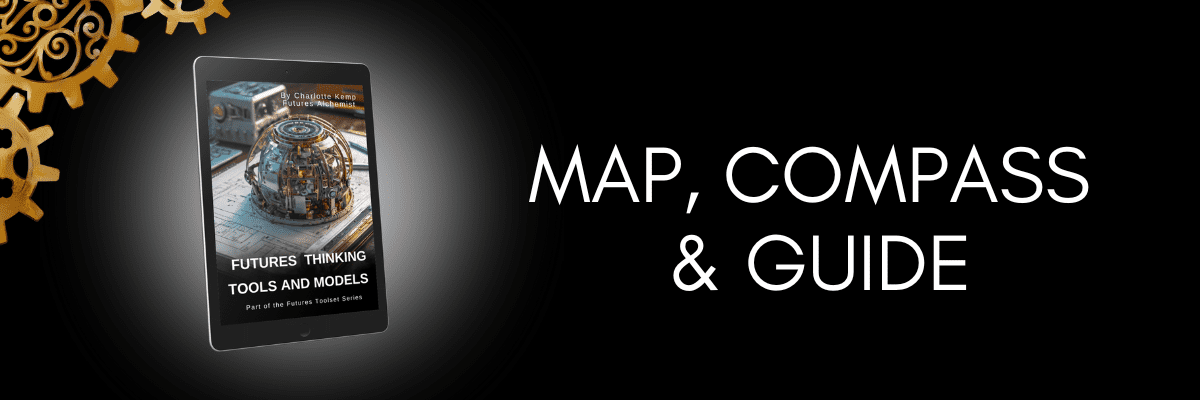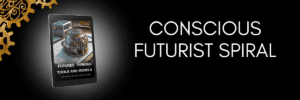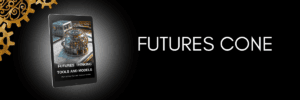
Introduction
The Map, Compass, Guide model is an original framework developed by myself to help individuals and organisations navigate uncertainty with better clarity and confidence. It draws on the timeless metaphors of exploration. Although we may slip into the language of calling it a ‘journey’ the real metaphor is of an expedition into a new land.
With a journey we are quite certain of the destination and can use a GPS to navigate the fastest or most efficient route, but we don’t know the exact destination for the future. So the expedition, into an unknown land, the ‘Terra Incognita’ becomes a better metaphor.
The model is especially useful at the beginning of a foresight journey or during moments of deep transition, where established maps have become obsolete, and leaders are unsure of the way forward. Using the language of this map and compass, creates the opportunity to discuss the future and our concerns, without falling into jargon.
What It Is
The model includes three core elements:
The Map
The map represents your current understanding of the world, your mental model, your knowledge, and the landscape of possible futures. It answers the question: “Where are we now, and what is the terrain ahead?”
The map is a representation of time. One third of the way into the map is our current moment in time. It is represented by a gem with different facets. Those facets represent our different perspectives even in a shared moment. This is helpful for teams to realise that they all view their current circumstance, their history and ultimately their future through different lenses.
To the left of the map is our past, our history. It is represented by two towns. Turvallenen is a closed city surrounded by a wall offering its inhabitants protection but limiting their opportunity for growth and exploration. The second time is Imvelapi, representing a more open and integrated approach to the environment where the inhabitants are aware of the cycles of life and have developed appropriate responses to recurring changes and potential dangers threats.
The map has various dangers such as sea monsters, dangerous shorelines with shipwrecks, dragons, ravines and more. These dangers are representative of the dangers in our world in terms of disruptions, market changes, changing political or economic circumstances et cetera. The map also offers some potential, suggested, and theoretical destinations, some of which are exclusive and exclusionary or alternatively open and engaging with other cultures.
In work with companies, this map can be redrawn to use metaphors and naming conventions appropriate to the relevant circumstances.

The Compass
The compass encompasses all of the tools that we can use to navigate this map. More details about the Compass can be found here but in summary it looks at four stages:
- gathering intelligence,
- managing change,
- describing the future, and
- testing our strategy.
The compass gives us direction in our expedition into an unknown future by being aware at what stage we are at in terms of developing a path forward. We gather intelligence from various sources, prepare our teams to move forward in the space of change, describe which future we are aiming for in which we wish to avoid and then when we get to the strategy testing phase to assess where we are at and to prepare for the next part of the expedition.
The Guide
The guide in this particular model when presenting this for the first time is myself. But a good guide does not just support people on an expedition but transfers those skills and insights from experience, to the next generation of guides. There are no gurus. There are no experts, and the future cannot be predicted perfectly but seeking the support of a guide who is experienced in navigating the unknown, is helpful at the start of an expedition.
Why It Works
The strength of the Map, Compass, Guide model lies in its emotional and intellectual accessibility. Everyone has experienced navigating change, feeling lost, or seeking direction, which makes this model instantly relatable. But its real value lies in how it integrates external intelligence (compass), internal clarity (map), and social support (guide) into one unified approach to futures thinking.
Many strategy tools focus on data and logic, but overlook values and human factors. This model restores those elements. It reminds us that people don’t just need information to move forward, they also need orientation and support.
It also complements other foresight tools beautifully:
- Your map may be developed using horizon scanning or scenario planning.
- Your compass may be clarified through visioning, ethical reflection, or backcasting.
- Your guide may emerge through coaching, community, or intergenerational knowledge.
Together, these elements help reduce paralysis in uncertainty and empower meaningful action.
How to Use It
You can use the Map, Compass, Guide framework as a:
- Conversation starter: A way to frame strategic dialogue about where your organisation is and where it wants to go.
- Diagnostic tool: To assess which of the three elements may be missing or weak during times of change.
- Reflective model: For individuals in leadership, career transition, or identity exploration.
- Onboarding tool: To help new teams orient themselves to a shared purpose and strategy.
Ask yourself or your team:
- Do we have a current and accurate map of our environment and future possibilities?
- Are we clear on our compass — the values and direction we want to pursue?
- Do we have a guide — people or practices that can help us navigate this journey?
In Summary
The Map, Compass, Guide model is a futures thinking framework grounded in timeless human needs of understanding, meaning, and connection. It doesn’t promise certainty, but it offers structure and support for navigating ambiguity. It reminds us that while the future may be unknown, we are not unprepared, and we do not travel alone.
Origin
Charlotte Kemp, 2019





